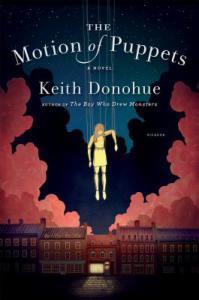Title: The Motion of Puppets
Author: Kevin Donohue
ISBN: 9781250057181
No. of Pages: 272
Genre: Horror
Origins: Picador
Release Date: 4 October 2016
Synopsis:
“In the Old City of Québec, Kay Harper falls in love with a puppet in the window of the Quatre Mains, a toy shop that is never open. She is spending her summer working as an acrobat with the cirque while her husband, Theo, is translating a biography of the pioneering photographer Eadweard Muybridge. Late one night, Kay fears someone is following her home. Surprised to see that the lights of the toy shop are on and the door is open, she takes shelter inside.
The next morning Theo wakes up to discover his wife is missing. Under police suspicion and frantic at her disappearance, he obsessively searches the streets of the Old City. Meanwhile, Kay has been transformed into a puppet, and is now a prisoner of the back room of the Quatre Mains, trapped with an odd assemblage of puppets from all over the world who can only come alive between the hours of midnight and dawn. The only way she can return to the human world is if Theo can find her and recognize her in her new form. So begins the dual odyssey of Keith Donohue’s The Motion of Puppets
: of a husband determined to find his wife, and of a woman trapped in a magical world where her life is not her own.”
My Thoughts: On the surface, The Motion of Puppets has everything that would make it a great story – puppets that come alive at night, a mysterious disappearance, two lovers torn apart and their desperate search for each other. Yet, something is missing. It is a story where the only driving force of the narrative is Theo’s ongoing search, and there is nothing surprising about the fact that he will eventually find her. There is no urgency. There is no fear. There is no mystery.
Then there is the novel Theo is translating. Eadweard Muybridge is the man who gave us the first stop-motion images of a horse galloping and solved the question of whether a horse always kept one hoof on the ground at a time. Much of Theo’s section of the novel is spent thinking about Muybridge, his life in the abstract, and his life-long scientific study of capturing objects in motion through photography. While the irony is not lost on readers, the true purpose of the focus on Muybridge may be. The key to the lessons such parallels provide is to feel a connection to the characters. Theo is not a character with whom most readers will connect, however, rendering any lesson or major point to be gleaned by his research of Muybridge to be moot, or at the very least not worth the effort necessary to discern it.
At the same time, the language within The Motion of Puppets is a bit too pragmatic for the subject matter. With puppets who used to be human beings, one expects a certain level of flowery prose to add to the fantasy. There should be adequate mood setting and a hint of mystery within each sentence to set the right tone. Mr. Donohue uses none of that. While his descriptions of nature are indeed picturesque, his descriptions of the people and puppets are less so. There is a matter-of-factness to these scenes which strips away the mysticism and renders the entire thing more depressing than creepy.
Have you ever finished reading a book knowing that you are missing some great point the author is trying to make but not interested enough in the story to want to sit and figure it out? Such is my experience with The Motion of Puppets. There is an obvious connection between Theo’s research and Kay’s transformation, but I have no desire to take the time to think about it. At the same time, there is a connection between Kay’s profession and Theo’s research; I know it is there, but it does not interest me in the least. Part of the problem is that what I wanted – a spooky story about puppets that are alive – is not what what I got. The Motion of Puppets
may be about puppets who are alive, but it is anything but unsettling and a lot less interesting that one might think. Kay’s experiences are too narrowly confined, and Theo spends almost as much time thinking about Muybridge as he does searching for his wife. The characters are flat with little backstory and no development. The resulting story has a plodding feel to it, as the pacing limps along until such a time as Theo is ready and able to make a move. By the time that happens, it is almost too late for readers to actually care what happens.

BOTTOM LINE: I wanted it to be scarier than it actually was.
